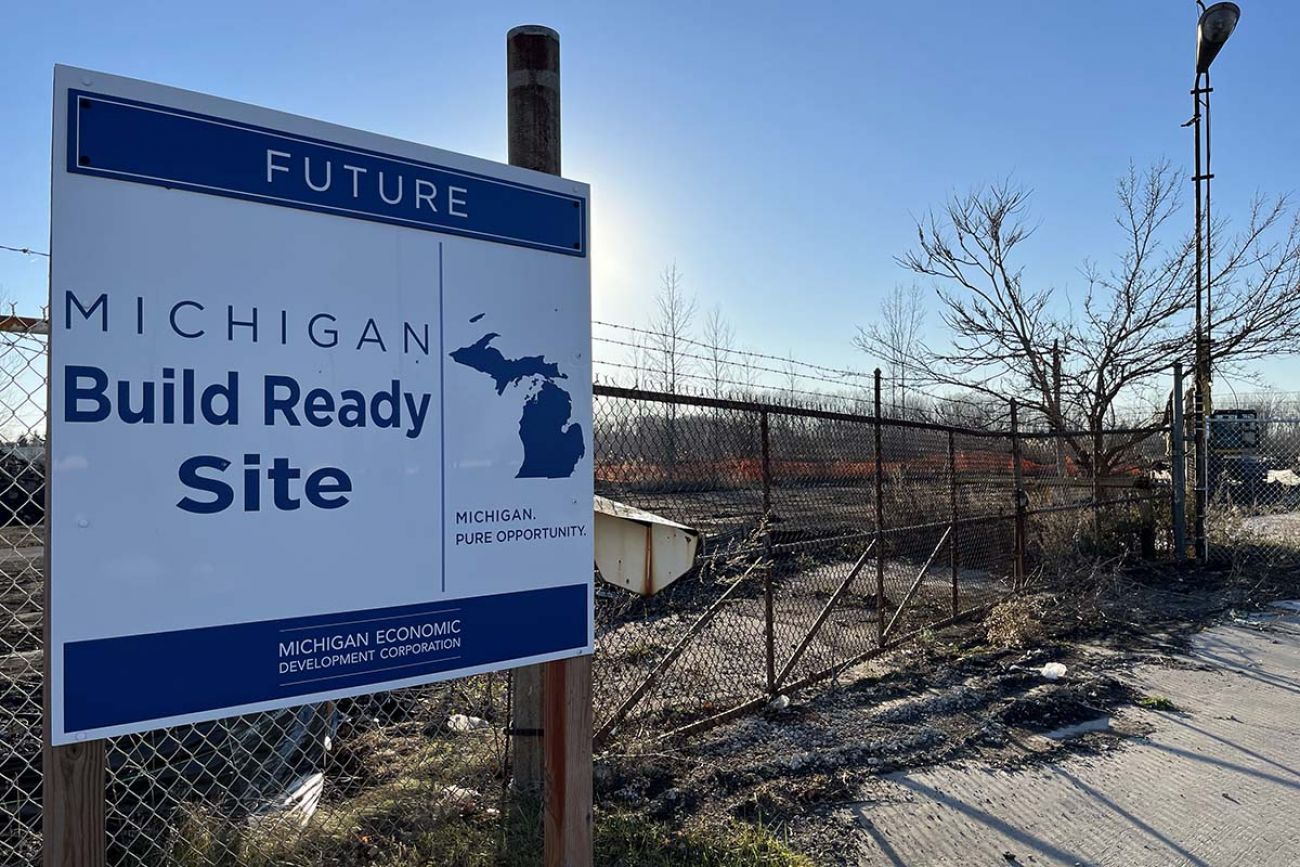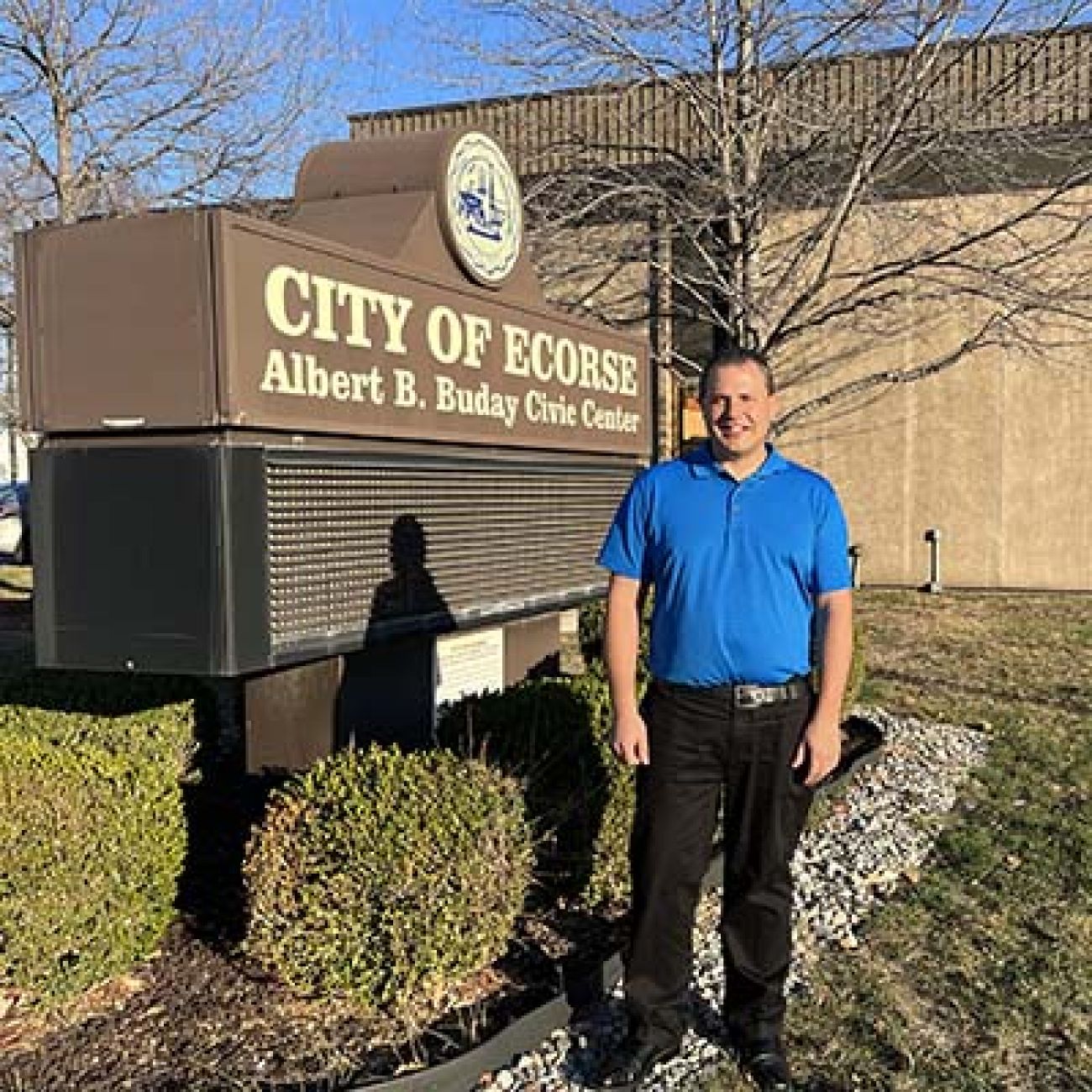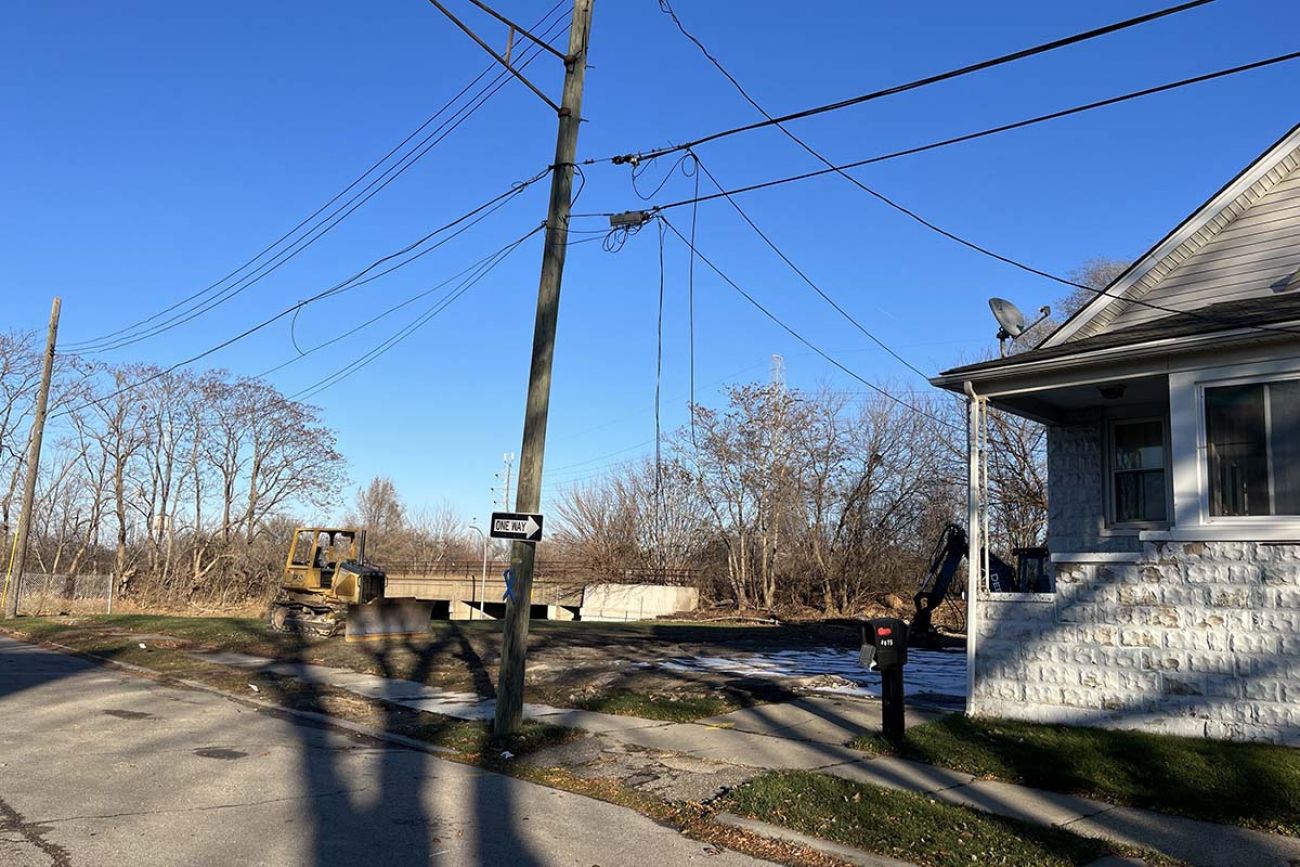New program gives SE Michigan an edge in hot industrial real estate market

- Industrial real estate demand is strong in metro Detroit as companies seek new buildings to serve the EV market
- A pilot program by the Detroit Regional Partnership seeks to give the area a competitive edge by pre-vetting properties for build-readiness
- By identifying build-ready properties, smaller businesses should find places to grow alongside the megasites the state is pursuing.
ECORSE — Late afternoon sun is shining on the Detroit River along this shrinking industrial city south of Detroit, which is set to open a long-awaited marina next summer.
But city controller Tim Sadowski drives right past it, turning west on Southfield Road to head away from the waterfront. He takes a series of turns through worn residential streets to reach what he calls the city’s best bet to stabilize its financial future.
The Mill Street Property — 66 acres of industrial blight bordered by homes, rail lines and the Ecorse River — could become home to as much as one million square feet of new warehousing that’s in demand by metro Detroit automakers and suppliers.
Related: Another real estate shortage: Grand Rapids running out of industrial space
The path to the transition represents “our Hail Mary pass,” Sadowski said, describing how Ecorse has spent the year trying to get the property development-ready in 2023.
Among the millions spent in federal, state, county and municipal funding aimed at making the long-vacant property viable, $3,000 paid to the Detroit Regional Partnership signals how regional leaders are seeking to urgently sell southeast Michigan’s development potential.
The Detroit Regional Partnership, which facilitates economic development across 11 counties around metro Detroit, expects to expand a pilot program in 2023 that evaluates available land, like this industrial expanse in Ecorse, and quickly market them to site selectors as build-ready.

The regional group’s Verified Industrial Properties (VIP) project prioritizes economic development funding for properties that are ready for industrial development. Similar efforts are expanding across the United States amid a national building boom driven by companies seeking electric vehicle production capacity and warehouse space.
One of the key components to landing a deal: fast turnarounds from signing a contract to operating a new facility. Maureen Donohue Krauss, president and CEO of the regional partnership, said that being able to offer site selectors development-ready properties is key to making the region more competitive.
“We need to operate at the speed of our customer,” Krauss said. “No one’s … telling us, ‘We want to be in (a new facility) in four years.”
The timeline of opportunity has become drastically shorter; in some cases, companies want to hear that they “can break ground tomorrow.”
Michigan upped its aggressiveness in attracting industrial development in 2021 after hometown Ford Motor Co. bypassed the state for $11.5 billion in high-tech electric vehicle battery manufacturing, choosing sites in Kentucky and Tennessee.
The auto industry’s EV overhaul is creating massive demand for facilities for new components as the pandemic’s “reshoring” of manufacturing started a push for industrial buildings, including warehouses. Large-scale factories will account for about $40 billion in U.S. investment in coming years, according to the Federal Reserve.
Today, the state is prioritizing large-scale projects. It allocated $5 million this year through the Michigan Strategic Fund to prepare five sites of 1,000 acres or more.
In contrast, the Detroit Regional Partnership’s new program is intended to bring smaller properties into play — some as small as 20 acres in a city or 40 acres in surrounding areas — that can add dozens to hundreds of jobs to an area.
Several real estate listings exist for smaller properties that could accommodate a 100,000-square-foot building or small industrial park. But few of them have detailed and recent evaluations done using criteria a buyer would need to know to make a decision to build quickly, which is what makes the Detroit Regional Partnership’s work valuable. It can provide site selectors information on access to utilities, workers, topography, contamination risks and transportation options, all of which has been vetted by VIP-contracted engineers.
Timing is critical for today’s heated market, said Jared Friedman of Friedman Real Estate of Farmington Hills.
“Demand for industrial space is really strong in our region,” said Friedman, who is developing and marketing the Mill Street property for Ecorse with General Development Co., based in Southfield. “And it has a lot to do with electric vehicles.”
Prime time for industrial development
In metro Detroit, the vacancy rate for industrial space at midyear was 4.5 percent, according to Colliers commercial real estate firm, representing a near-record low. That, the international firm said, prompted 9.9 million square feet of new construction across the market.
A low vacancy rate for industrial space can curtail development, as Grand Rapids found in 2021 when its available space dipped to 1.7 percent in a market of over 100 million square feet, creating pressure for any company needing space to expand.
To make its new site verification program work, the Detroit Regional Partnership started its trial program with nine build-ready properties. Another 20 or so are in the pipeline.
By early 2023, the regional partnership said it will increase its build-ready real estate reach, funded by a $5.5 million U.S. Economic Development Association grant it won in September as part of a $52.2 million award to six economic development groups.
“We will be adding staff, consultants … and accelerating the program,” said Shannon Selby, vice president of real estate for the Detroit Regional Partnership. Eventually, the program will be able to assist communities and other landowners with master planning and on-site studies.
The biggest customers so far are municipalities, many of which have pandemic American Rescue Plan Act funding that could make their industrial park property more appealing to a buyer, but need help to identify which steps will be most meaningful. Krauss noted the importance of adding utilities and roads. Some private developers also seek to boost listings through the site verification process.
Friedman, the broker of the Mill Street property in Ecorse, said site verification also helps with marketing, since the regional partnership is well-connected with site selectors working on behalf of industrial clients.
He expects an eventual deal on Mill Street with a client that needs to be between a Canadian border crossing, including the Gordie Howe International Bridge when it opens in 2025, and Ford Motor Co. in Dearborn.
While the Ecorse property has languished over the years, the time is right for it to become more competitive — and it’s unique in the marketplace, Friedman said.
“It's hard to find sites that large and contiguous ready to go,” he said.
Krauss said that should be the power of the VIP program, as it conveys to an active market how rare a property may be — along with its value to their development timeline. A verified property in an industrial park in Monroe County’s Luna Pier, for example, already is under contract. Other sites include industrial parks in Livingston County’s Handy Township and Owosso in Shiawassee County.
Pricing the land isn’t part of the VIP program, Selby said, but it is discussed as she accepts a property into the program to prevent what she called an “unreasonable owner.”
The goal, she said, is “to get projects built on these sites. We want to create jobs and we want to get capital investment.”
A community hopes
West Jefferson Avenue is the main commercial thoroughfare for Ecorse, built more like a wide highway for commuters through the city than a conduit to a downtown, and the sparse storefronts speak to vehicles that drive by without stopping. A handful of the remaining dozen or so restaurants closed during the pandemic, city controller Sadowski said. The city has no grocery.
John D. Dingell Park’s new splash pad and kayak launch, built with $1.6 million in federal grant funding, will be a city destination next summer, Sadowski said, and so will the new marina, also opening in 2023.
The city’s 9,000 residents — a number that has declined about 18 percent over 20 years — need access to recreational opportunities, Sadowski said. Most residents don’t own a car and one-third live below the federal poverty line of $26,500 for a family of four, compared to about 13 percent for the state as a whole.
At the same time, Ecorse, which has long battled financial pressures, needs a way to bolster its tax base. Which is why getting the Mill Street site ready for industrial use is a priority.
The property has a complicated history, with the city buying it from U.S. Steel for $2 million nearly 20 years ago. Sadowski said the city expected the sale of steel that was left on the site to fund redevelopment costs, but that didn’t happen. And as the Great Recession hit Michigan, Ecorse struggled.
Potential opportunities arose over the years, including residential housing, but without an updated engineering review, the unknowns at the property — including contamination clean-up costs — meant little could happen quickly.
That pace started to change in 2020, as the Michigan Economic Development Corporation chose it as a “build ready” site, awarding $100,000 in 2019 and $75,000 a year later. The city added its second round of ARPA funding, about $500,000, and other grants, including from Wayne County.

The first thing Sadowski did with the latest funding was knock on doors on one side of the city’s 1st Street in the neighborhood of pre-war bungalows between Southfield Road and Mill Street. He persuaded owners to sell to the city, clearing the way for truck access to the main thoroughfare that soon will connect it to highways and Canadian bridge crossings. Work on the new route will start in early 2023.
More funding needs remain, and Sadowski said he is aggressively pursuing them. Another $600,000 may come from the state to resurface Mill Street. A cleanup grant worth $1 million is sought for the estimated hazardous material that remains. The city hopes for a walking path and bridge over the river to connect the site to Lincoln Park.
Funding pressure continues beyond Mill Street, Sadowski said.
U.S. Steel used to be Ecorse’s largest employer and it still operates a facility on the north end of the city, but it’s down to 500 workers doing finishing work, after the company laid off 1,500 workers in 2020. The company contributed about $2 million in tax payments to the city’s $13 million general fund, and another $4 million to its water and sewer budget. But the budget represents about a $5 million deficit, and that — along with the city’s reliance on the steel mill — drives Ecorse’s development urgency, Sadowski said.
The Mill Street development could mean 1,000 new jobs coming to the city, based on the allowed building size and projections from Friedman of the development team. No prospective tenant has been publicly identified, he added.
All of the funding so far has been “extremely lucky” for Ecorse, Sadowski said, adding that he hopes the state-level support remains in the coming year, when Democrats take control of the state’s legislature.
The VIP program’s expected growth could lead to more collaborations around the state to elevate vacant industrial land, said Selby, the real estate expert for the Detroit Regional Partnership.
Moving beyond the use of real estate listings to distributing information on vetted site-ready property will be, Selby said, “the catalyst for job creation and infusion of capital …. to change the course of communities.”
Business Watch
Covering the intersection of business and policy, and informing Michigan employers and workers on the long road back from coronavirus.
- About Business Watch
- Subscribe
- Share tips and questions with Bridge Business Editor Paula Gardner
Thanks to our Business Watch sponsors.
Support Bridge's nonprofit civic journalism. Donate today.
See what new members are saying about why they donated to Bridge Michigan:
- “In order for this information to be accurate and unbiased it must be underwritten by its readers, not by special interests.” - Larry S.
- “Not many other media sources report on the topics Bridge does.” - Susan B.
- “Your journalism is outstanding and rare these days.” - Mark S.
If you want to ensure the future of nonpartisan, nonprofit Michigan journalism, please become a member today. You, too, will be asked why you donated and maybe we'll feature your quote next time!




